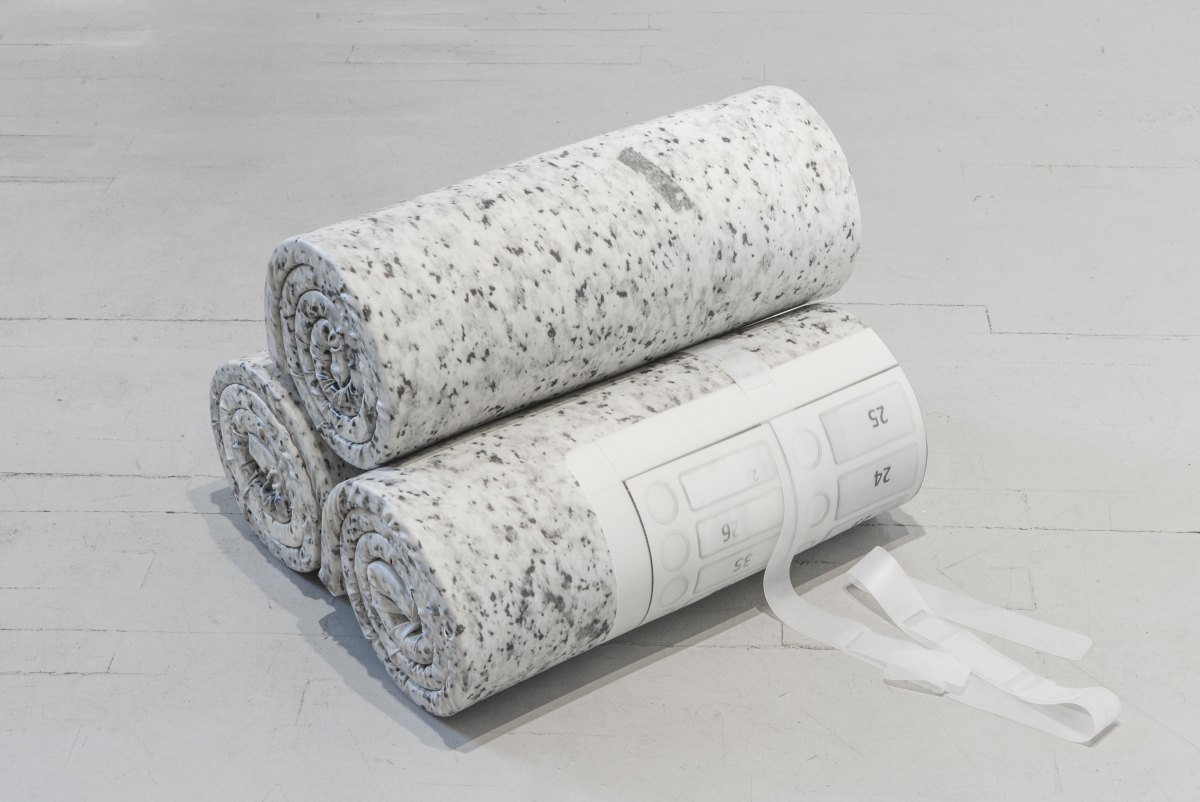
Neringa Vasiliauskaitė, Towels, 2018
This year, from 29 October to 30 November, the Vartai Gallery in Vilnius showcased ‘Four Rooms with a View’ (Keturi kambariai su vaizdu). In the exhibition, five contemporary artists, Aron Mehzion, Anastasija Sosunova and Andrea Zucchini, Neringa Vasiliauskaitė, and Johannes Wald, presented sculptural objects and installation art. The concept of Daniel Marzona, the German curator and publisher,[1] was to let the artists turn each of the rooms into a separate visual narrative; or, in other words, to let them curate their own parts of the exhibition, which consequently led towards a modal reading of the sculptural objects, the evaluative relation to them, and the functional means by which the objects are allowed to exist in the four rooms at the Vartai Gallery. In any case, the exhibition’s curatorial strategy did not contain much … In the post-capitalist buy-and-sell-art market, the evaluation of an artist is based on nothing other than institutional validation, that is, when the value of an artwork, or even an artist, is determined in the negative-critical state of the moment. And so, the tempting offer to set up a ‘private’ space in an institution which has been successfully creating itself[2] for over two decades makes us wonder about the factual status of the entities encountered in the exhibition, or the ‘causes’ and ‘effects’ attributed to them.
In the phrase ‘the rumble of thunder’, by the method of reduction, the particular elemental sound (the rumble) is made into a kind of status for the thunder to appear. In the same way, the relatively young artists whom the commercial gallery represents are therefore granted a certain level of ‘prestige’. This is clear to every visitor before they have even crossed the gallery’s doorstep, and so it should not upset visitors. As was accurately expressed by Professor Suhair Malik, a director of Fine Art Goldsmiths (London), during his visit to Vilnius, these days, any de-standardised or marginal creative practice is turned into a tool of the market by the simple: ‘Oh, but we do love your revolt!’,[3] thus legitimising the protest in general. So the myth of a lone genius working in his studio on a new ‘revolution’ does not have much in common with the exhibition in question (or with how its objects came to be).
To construe the exhibition’s value and structure, it seems much more important to distinguish and define when and how the efficacy of the particular artworks, or the aformentioned ‘prestige’, manifest themselves, by the equivalent relationship between the ‘agent’ (the artwork) and the ‘action’ (the exhibition’s existence, its openness to the public, and its importance in the field of contemporary art), and when, quite possibly, an artwork’s ‘cause’, which had been conceived in the plane of intentionality, obtains its ‘effects’ through intitutional ‘enrumbling’ only, by the selection of the space, the bursts of photographers’ flashbulbs, the murmurs of a doubtful viewer, or the ideological success or shortcomings of the exhibition’s ‘roommates’. That is why this article is not an institutional critique of the gallery’s room. If such a goal was set, we would immediately find ourselves in the modus of institutional activity of Vartai and the Galerie Daniel Marzona, and the contexts surrounding it: appearances at international art fairs, the success stories of the represented artists, or, in the end, yet another ‘selection’ of white cube criticism. This article seeks to enter into each of the ‘Four Rooms with a View’, to absorb the artistic methods and forms, and the surfaces and narratives with which the artists fill up the chambers with the lives of contemporary sculpture.

Neringa Vasiliauskaitė, Tablecloth (2), 2018
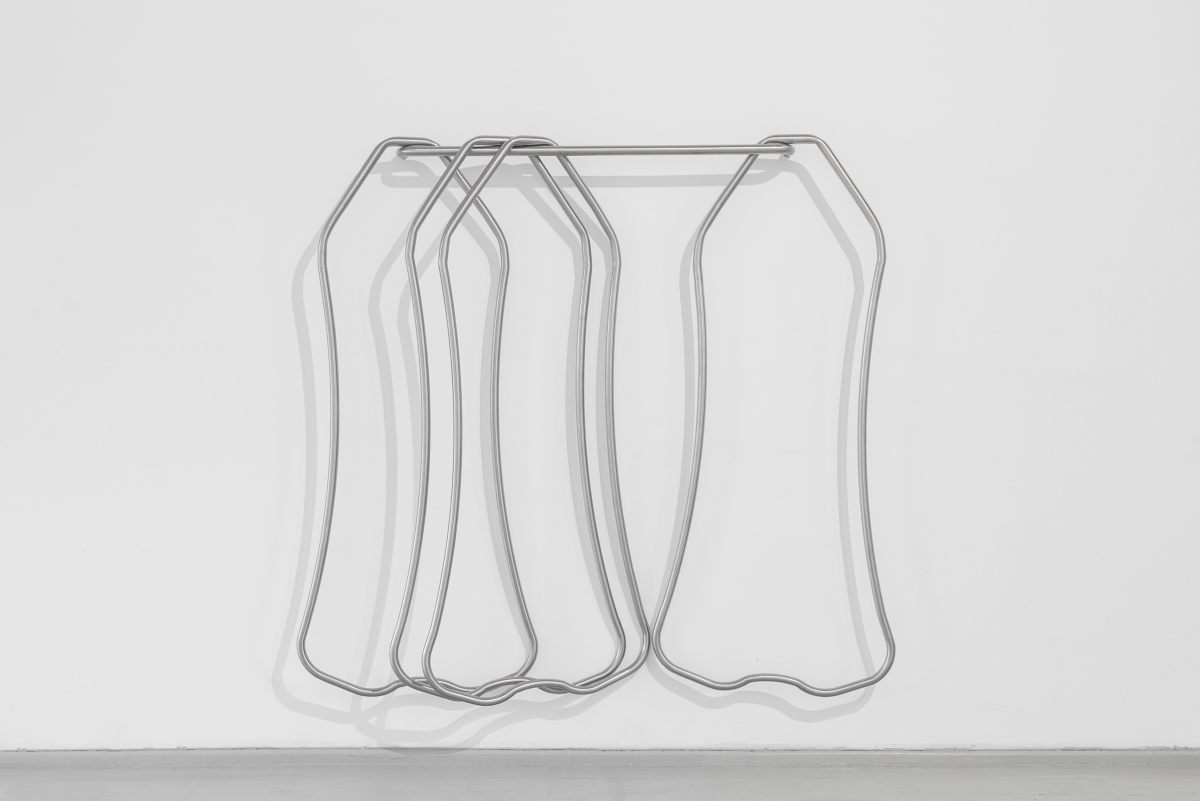
Neringa Vasiliauskaitė, Hanging, 2018
Room No 1. Neringa Vasiliauskaitė. Towels (Rankšluosčiai), Tablecloth (2) (Staltiesė Nr. 2), Hanging (Kabantis), Observer (Stebėtojas), Tablecloth (1) (Staltiesė Nr. 1), all 2018
The artist Neringa Vasiliauskaitė, who is based in Münich in Germany, does not tire her viewers with the linguistic structures that are widely used in the language of contemporary art, with the signification games that so frequently recur around various art centres, or which can merely express the conceptual shifts ‘from word to body’ and back, which in themselves attempt to validate the founding strategies for perceiving a work of art, to simulate the preferred guidelines for such perception. Vasiliauskaitė’s unexpected and aesthetically pleasing sculptural objects (Towels, Tablecloth, Observer) attract our attention, while their subtle materiality and meticulous technique incite us to touch, to examine, and, on the level of ideas, to marvel at the modified forms of perfectly familiar yet cleverly contextualised everyday objects. As fashionable restaurants attempt to make their product ‘instagrammable’, we could humorously say that in the art market, Vasiliauskaitė’s pieces work in a similar way (and that primarily reveals her solid and well-thought-out aesthetic stance). A less-experienced visitor will surely notice ‘Your coat is a perfect match for the Tablecloth’s rose neoprene,’ chosen as a basis for the UV prints … However, there are no accidental details in Vasiliauskaitė’s artworks: a smooth, voluminous Tablecloth reposes with its silicone straps on a granite slab, while the object’s proportions ‘protect’ the viewer from paying too much attention to the formality of its expression. The same could be said about the piece Towels, whose clean textile folds are impeccably depicted by the print-coated latex shrouding the dainty cylinders of foam rubber. Thus, understanding of how Vasiliauskaitė conceptualises her sculptural objects, and it is very important here to consider the material’s compliance with the discussion about what different sentiments it may evoke, makes the ‘literary’ interpretation of our present day’s surfaces possible only through this selective, reductionist and technically constructed imaging. The artist distances herself from any ‘handicrafts’, and in this way turns her pieces into socio-political remarks, whose ideological charge is strengthened not by an abstract speech on the objects, but by the presented object’s institutional being not present in our everyday.
Vasiliauskaitė’s works Hanging and Observer, which actually partition the room’s space, use the previously mentioned artistic strategy in a more subtle way. The abstract forms and ‘enacted’ materiality reveal these objects through the subtext of their operation, rather than by functioning in the aesthetic sphere of the impossible (because, in this case, functional obscurity is not just an expression of the chosen materials, which are themselves the initial ‘causes’ of the work). As in the installations by Neringa’s teacher Nicole Wermers, the winner of the Turner Prize in 2015, these works highlight the connotative features of a separated object (for example, Observer can be linked to the mobile partitions used for formal receptions, exhibitions, and so on, and also to the corresponding power relations, the means of keeping the structure up. Meanwhile, Wermers’ famously successful installation Infrastruktu (2015) used fur coats, which were hung from modernist chair backs, and in that way symbolically and temporarily ‘owned’ parts of the public space, to claim the personalisation of that public space, marked by our design and industrial objects. Therefore, Neringa Vasiliauskaitė’s hyper-elevated steel stand supports the observing (worm-like, coiling, downright rapacious!) silicone strand, which lies imposingly across the floor, without, however, compelling anyone to ‘throw it off’, to get it out of the way. To be frank, Observer carries out its task completely: while we try consciously to circumvent the twists of the heavy rope, we are definitely being kept under surveillance. To attain this, all that is needed is the room’s institutional dimension, and then a straight, tough, quite high stand and a ‘shameful’, static silicone hose. Then the room rumbles with applause from the Observed.

Anastasija Sosunova and Andrea Zucchini, Scrolls and Heals, 2018
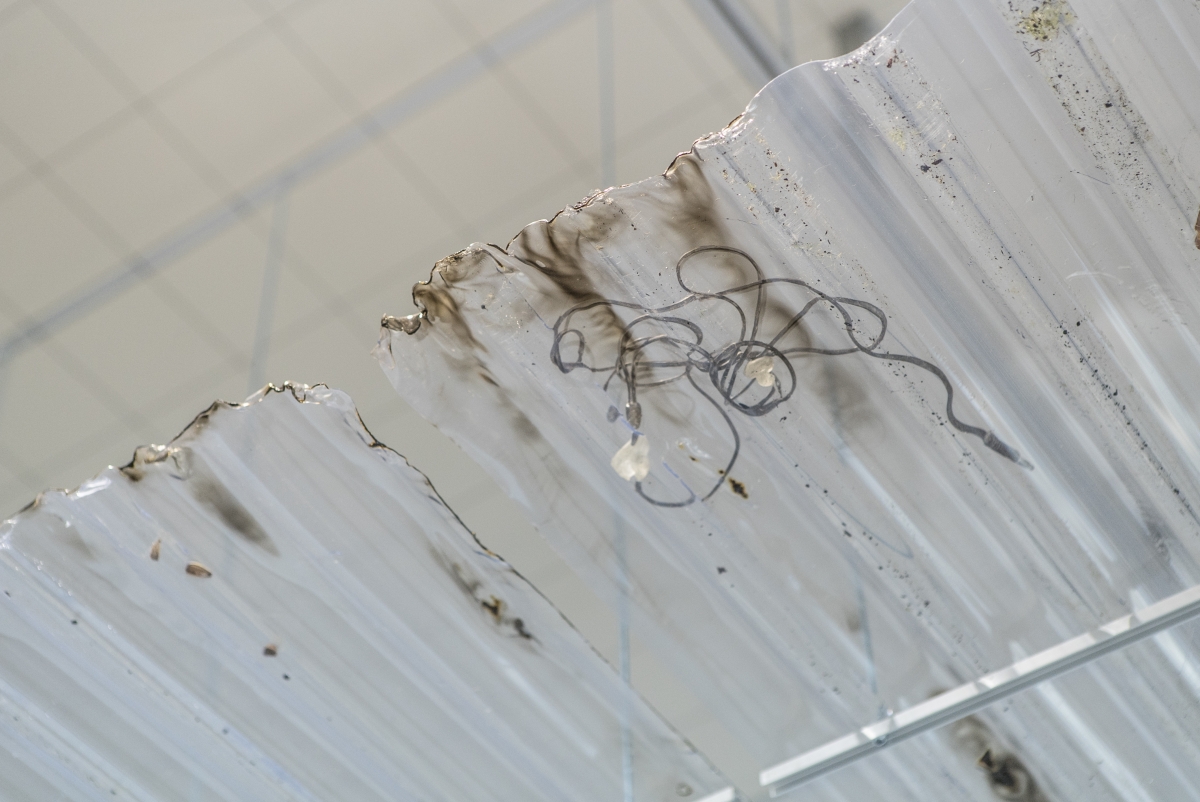
Anastasija Sosunova and Andrea Zucchini, Slow debate, 2018.
Room No 2. Anastasija Sosunova and Andrea Zucchini. Call Softly to one Another, Sleepwalker, Leftovers, Creeping and Healing, Lead Legs, Slow Debate, Heavy stomach, all 2018
Most of the objects by Anastasija Sosunova and Andrea Zucchini have already been on display and possibly seen by visitors to contemporary art galleries in Vilnius last April, in the Editorial project space, which showcased the duo’s exhibition ‘Second Skin’.
‘Mud is thicker than water. Impurities transfer energy. That’s why we got rid of them. We made the room resistant to all streams, protected from any influence or doubt. We ask you to leave the room alone. This space has suffered enough already,’[4] annotated the art critic Monika Kalinauskaitė. Thus, in an institutional context, ‘Editorial’ could be seen as an experimental, but undefined and therefore unconstrained, ‘foreseeing’ space of great merit, where the unconventional projects by the young artists could be given proper ‘editorial’ advice: in this place, Anastasija and Andrea’s ‘Second Skin’ has literally found its shelter. From the tin-plated wooden floor (which can freely transfer any dirt, any doubt or energy) of the Editorial Gallery, to the nuanced daylight lighting set up, the homey hustle and bustle of the public, and direct contact with the creators, the paradoxical name of the exhibition was fully justified within the synthesis of the epoxide, polyester, chewing gum, coal, sunflower seed shells and the burnt and found objects.
The traditional relations of urban qualities were replaced by the organic artificiality which Sosunova and Zucchini investigated anthropo-aesthetically, as an allusion to the post-industrial society producing and recreating itself, which functioned smoothly in such an incubated, ‘cleared-out’ environment, favourable to metaphorical experiences, where the aluminium ‘soil’ reflects any possible narrative coming from the outside of the exhibition. Therefore, the moment when the artists agreed to Daniel Marzona’s offer to recreate the ‘Second Skin’ narrative in one of the four rooms of the Vartai Gallery could be compared to an inversion of a long-established relation: all doubts and influences, to which the duo’s pieces were immune at the Editorial exhibition, have now become an integral part of their installation.
At Vartai, a peaceful and inquisitive observation of the transformations of late capitalism, when the broken links between bodies and communities are covered with a time-appropriate membrane (of clear synthetic resin), was manifested as the duo’s consciously processed and clearly formed institutional action. The previously mentioned ‘prestige’ seems to be neither the ‘cause’ of artworks by Sosunova and Zucchini, nor the status for their demonstration, although this ‘third dimension’ has become part of the atmosphere in one of the four rooms, which directly affects the biology of the entities inside. I should point out that I do not regard this shift as negative. In Marzona’s exhibition, some of the new pieces, such as the installations Slow Debate and Creeping and Healing, seem to escape the previously regular narrative (the slightly romantic background), and so raise even more insistent questions about a globalised home, a politicised body, or de-individualised memory. Found objects, unfit for their natural habitat, are shown as shapeless bodies protruding indistinctly from PVC ceiling plates, and which, together with the vacuum-processed plastic shield separating the lonely and unarticulated carbon fibre limbs (seeming never to have belonged to anything), repels any wish to grumble about the ‘vaingloriousness’ of the exhibited objects. The artworks by Sosunova and Zucchinni express contemporary angst, and, as the objects’ bodies metaphorically turn into the limb of an alien city, almost no one could be bothered about institutional prestige.
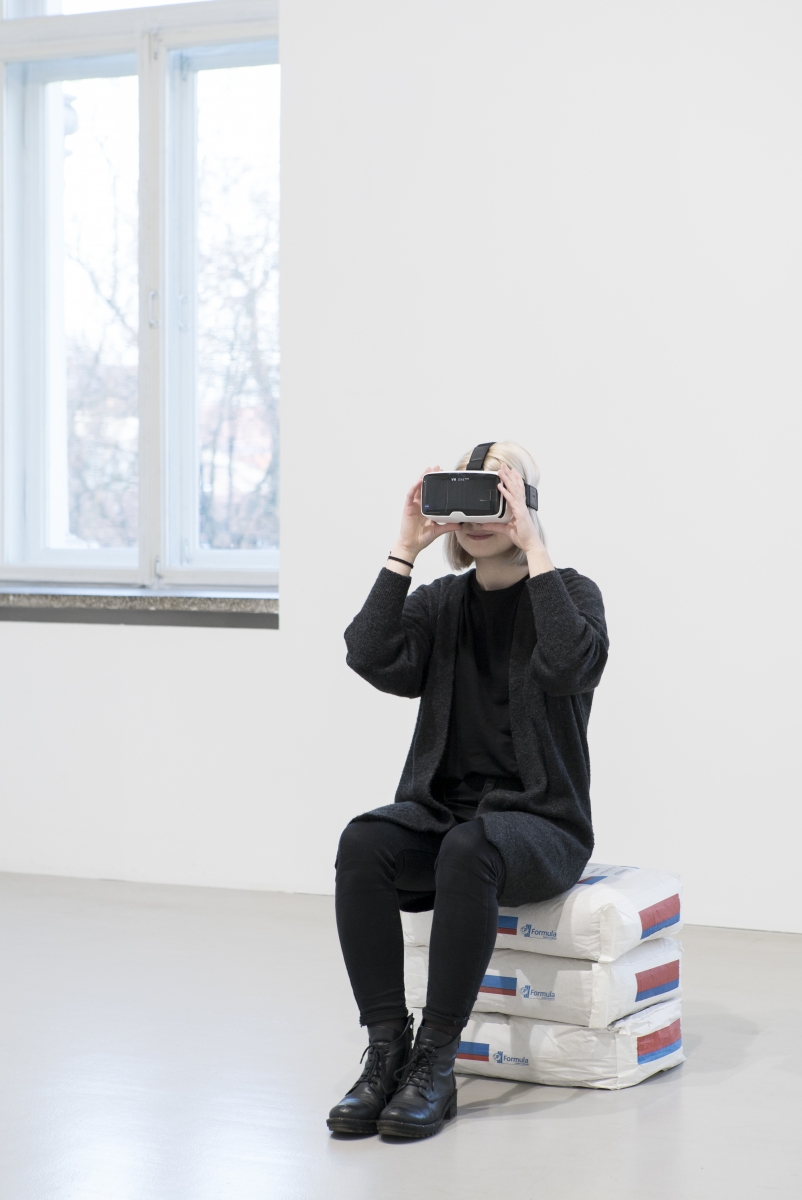
Room No 3. Johannes Wald. Various Poses (2014), Young Man Making Poses (in a fold of time) (2018), Stade su miroir / Mirror State (2018)
Johannes Wald is the only artist directly incorporating the space of one of the ‘Four Rooms with a View’ in the Vartai Gallery. The artist presents an installation consisting of three pieces situated at the corners of an imaginary equilateral triangle: dynamic plaster legs, hanging by threads as though they are marionettes (Various Poses, 2014), at point [A]; at point [B] a small volcanic glass plate, or a polished obsidian ‘mirror’ (Mirror State, 2018), in which you can see your own reflection and another artwork; meanwhile, at the imaginary ‘apex’ [C], one finds three industrial plaster bags and VR glasses, to watch the exhibition objects overlaid with visuals from an abandoned garage, loft or studio, that way involving yet another active subject. Although we began by saying how the artist evidently incorporates the space, the exhibition’s inclination towards conceptualism should not be cast aside here: Johannes Wald uses DIY aesthetics to create his visual ‘equation’, and so the viewer is left to decide and choose the most suitable state of materiality from all those available around the rooms in the exhibition. For centuries, artists have used plaster dust to embody ‘various poses’ (the Antique busts found in every drawing room do not even have to be mentioned), virtual reality glasses enable us to connect the objects with the ‘eyes of their creator’, and in the abstract rock ‘mirror’ you will find inspiration for new forms … Nevertheless, this artistic approach is rather didactic and mathematically dull, not only in the context of this exhibition, but in the context of our everyday, too. Compared to other artworks that I tend to regard as convincing and finalised reductions from form to concept (an example could be Liudvikas Buklys’ exhibition ‘Tongues Alike’ (2015), curated by Post Brothers at the Contemporary Art Centre in Vilnius, in particular Measurement Piece and Prototypes of Secondary School), the meaning of Johannes Wald’s objects hovers somewhere between ‘the rumble’ and ‘the roll’, never to become an ‘elemental force of nature’. As you enter his Vartai space, you feel as though you have entered a seventh-grade mathematics detention class, where the deepest sense is enclosed within a rectangle of lava, and at the back of the class hangs a blackboard with elementary geometric equations written all over it, and so they are used to fill the triangle with well-crammed prestige.
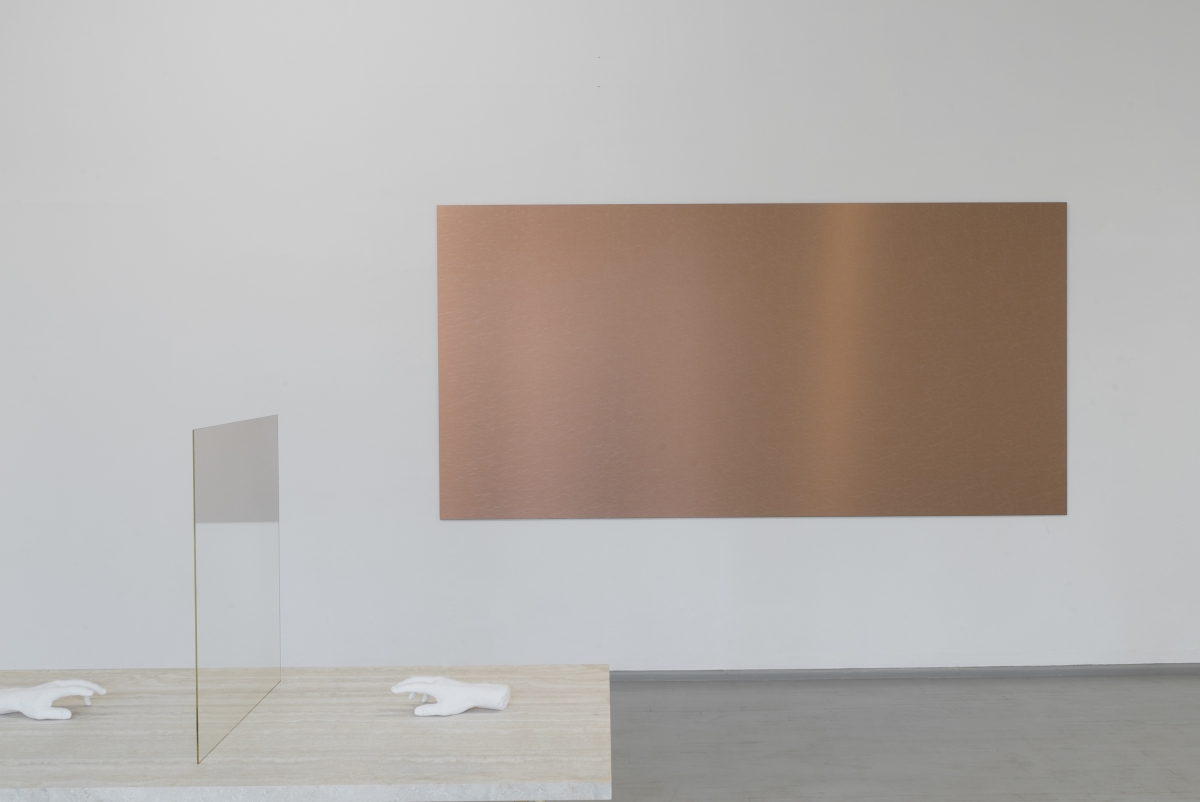
‘Four Rooms with a View’, Vartai gallery, 2018

Aron Mehzion, piège de l’apparition I, 2018
Room No 4. Aron Mehzion. Piège de l’apparition I (2018), Passage XVI (2018), Passage V (2016), Passage XVII (2018).
The last part of the exhibition is devoted to works by Aron Mehzion, which are resistant to even the most elementary curatorial strategies. Quite possibly, the institutional legitimisation previously mentioned in this article, or the illusion of a private space, serves Mehzion’s heterotopian (from Foucault) half-transparent mirror space, by defining it as a ‘world within a world’, reflective, yet deranging and deconstructing what is outside it. However, by being part of the institutional agreement, Room No 4 remains the only truly authentic space in the exhibition. Here, the illusory chambers become independent of the modal ‘cause’ and ‘effect’ relation, and so each visitor to the exhibition contributes to the artist’s intended visual dimension overlay, which flattens the hierarchy between the ‘real image’ and its ‘representation’. In the installation The Trap of Appearance I (Piège de l’apparition I), a half-transparent mirror is put between two 3D objects, two printed hands with five and four fingers, connecting the perfect appearance on the surface with the ‘lacking’ image on the other side of the glass. Thus, not only does the partition divide the space of the objects into two different dimensions (which oppose the institutional ‘veracity’), but it creates the third (to be precise, the fourth) space, which manifests itself as the habitat of a third hand, and which only exists in the representational utopian sphere of the visible object. This entity’s self-sufficiency and its independence of the efficiently defined (perfect, yet lacking) object world can be summed up by an accurate quote by Walter Russel Mead: ‘Utopia is a place where everything is good; dystopia is a place where everything is bad; heterotopia is where things are different — that is, a collection whose members have few or no intelligible connections with one another.’
Meanwhile, the other three pieces in Aron Mehzion’s series ‘Passage’ (2016–2018), the two-dimensional engravings Passage XVI, Passage XVII and the drawing Passage V, executed on anodised aluminium and matt lacquer plates, in a way signify the transition from the visible reality to the aforementioned heterotopia. The drawing is physically, yet organically, etched into a soft metal body, and the abstract ‘writings’ resemble the signs of an unmarked road, a micro-schematic ornament of ‘tensions’ and ‘tides’, a certain transitional algorithm. The previously discussed installation by Aron Mehzion The Trap of Appearance is surrounded by the ‘passages’ (passage in French, an excerpted passage) of the appropriately sized spatial code, and each and every disruption or stroke of the surface forms the object’s relief in its own way, by becoming a two-dimensional mark of a multi-dimensional process.
[1] Novado Press, established by Daniel Marzona and Elena Carlini in 2004, has focused on artist-books and questions of contemporary architecture.
[2] In February 2016, the Vartai Gallery and its founder Neda Rutkienė, who won a St Christopher Award for her contribution to contemporary art, invited guests to its 25th anniversary exhibition ‘Žilvitis’ (18 February to 2 April 2016). Founded in 1991, the gallery, according to the art critic Kęstutis Šapoka, has formed its targets in the discourse of contemporary Lithuanian art more clearly during the last six and seven years, by becoming a strong and sophisticated player on a strategic level, which can represent a particularly broad and deserving range of contemporary art practices (from painting and object art to performance and conteptual art), both from Lithuania and from abroad. ‘The ideological shift [of the gallery’s exhibitions] signifies the gallery’s aspiration to, apart from purely formal diversity, an engaging high-quality curatorial practice, when the notion of “contemporary art” symbolises corresponding socio-aesthetic currents and the pursuit of and regard for status in a particular institutional […] system,’ Kęstutis Šapoka, ‘The Vartai Gallery Turns 25’, Krantai (ed. H. Šabasevičius), Vilnius, 2016 (1), p. 25.
[3] The full conversation with Suhail Malik can be found in Vilnius Academy of Art’s publication VDA interviu: Ateities mokykla (VAA Interview: The Art School of the Future), published in late November, in which Suhail Malik is interviewed by Alberta Vengrytė (pp. 110-123).
[4] Anastasija Sosunova and Andrea Zucchini, ‘Second Skin’, 17 April to 19 May 2018, Editorial, Latako St 3, Vilnius. An extract from the notes to the exhibition.






























